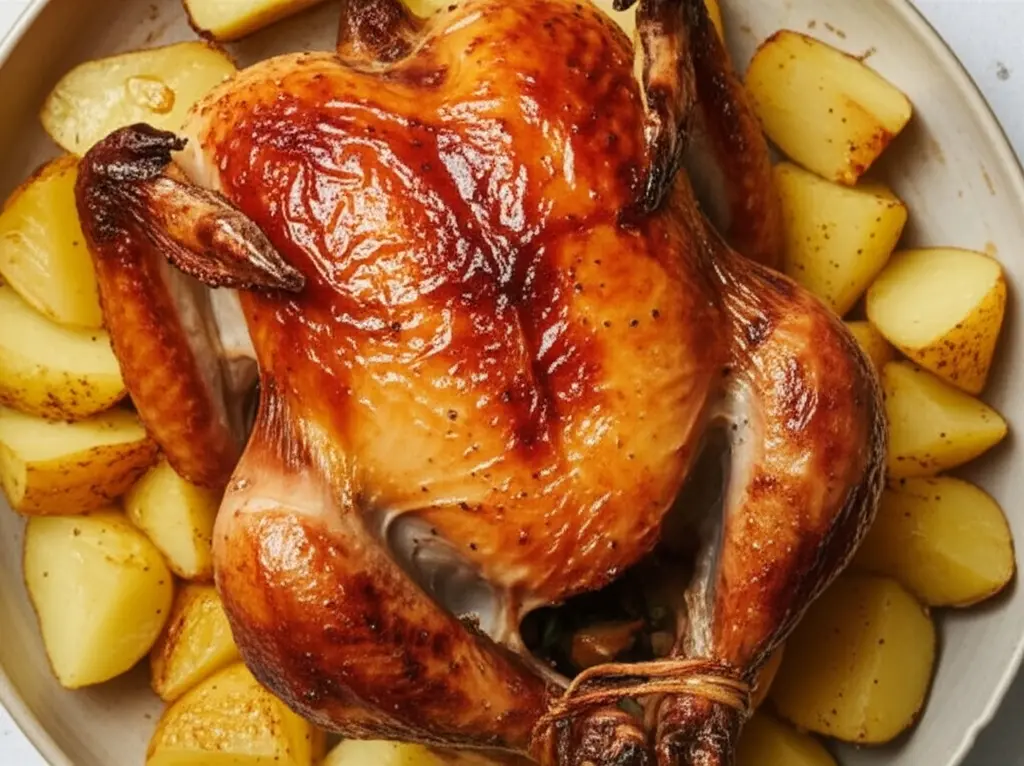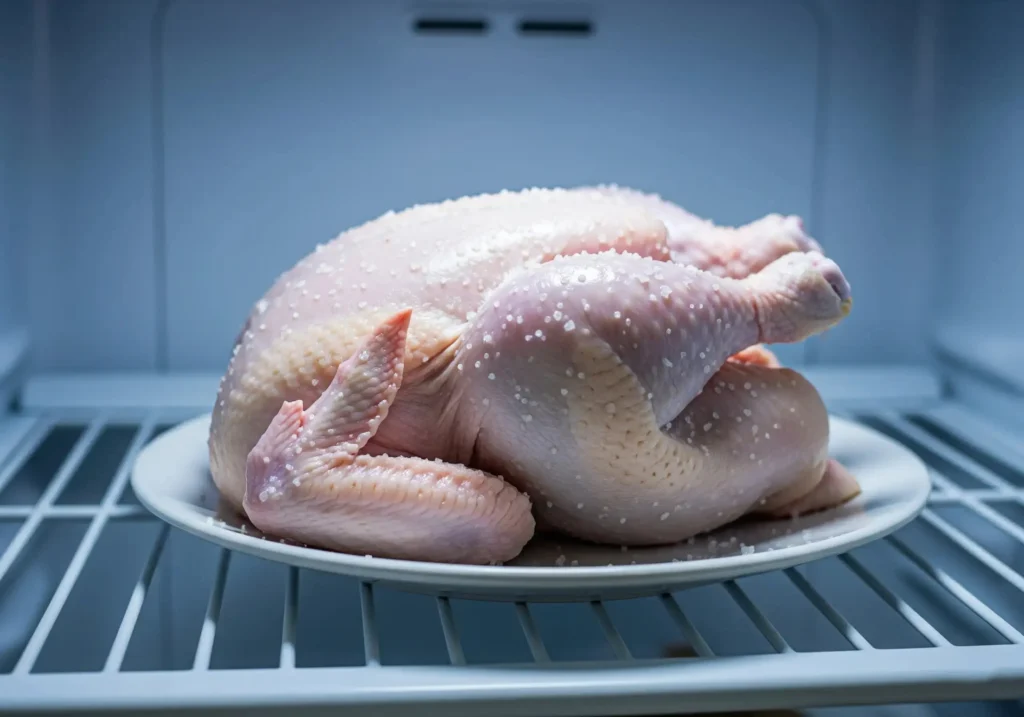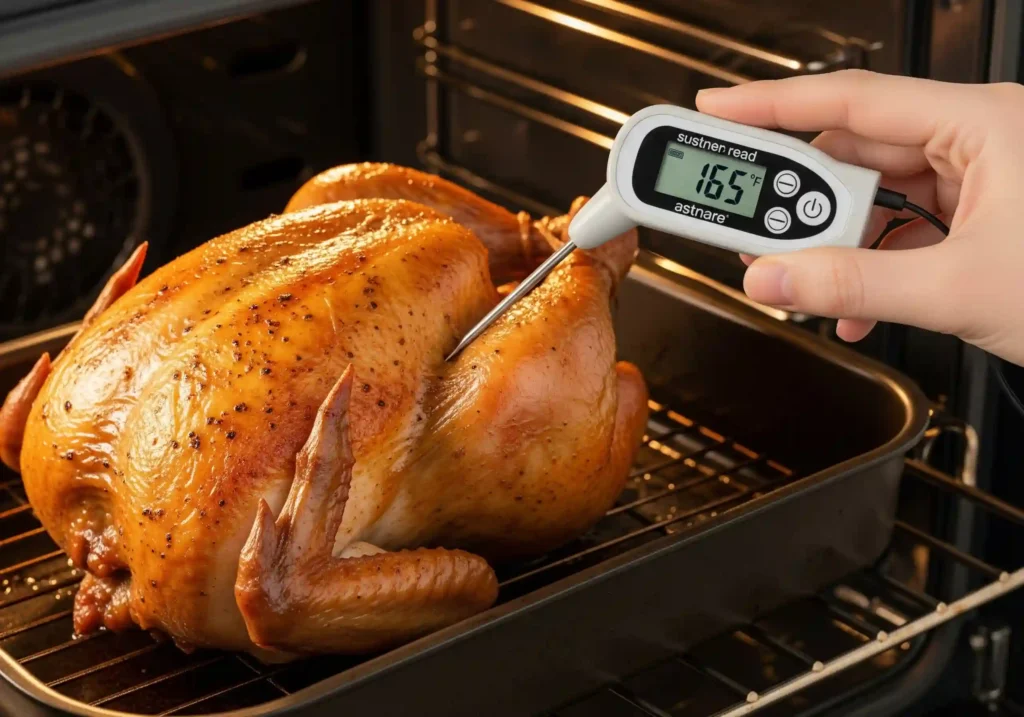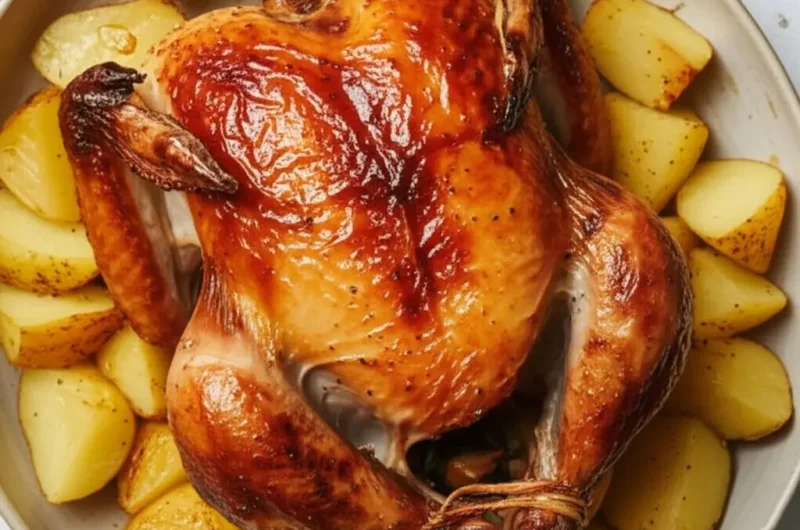The Perfect Sunday Roast Chicken
Before I dove headfirst into the world of food, I was a professional chasing deadlines on a calendar. Back then, Sunday dinner was the light I desperately tried to hold onto in the cracks of a busy life. And a perfect roast chicken was the focal point of that light. The moment that rich, warm aroma sneaks out of the oven and fills every corner of the house, it’s an unspoken signal for the whole family: it’s time to put down the phones, forget about work, and just be together. This isn’t just dinner; it’s the sacred time we carve out for each other.

A beautiful roast chicken is the soul of the Sunday table. When you bring that golden, glistening bird to the table, it’s a statement. It says, “This is special. This is for family.” And the best part? It’s a high-reward, low-risk kind of meal. The oven does most of the work for you. With a few key secrets, you can get a perfect result every single time, earning rave reviews from the whole family.
My Golden Rules for a Perfect Roast Chicken
Over the years, I’ve learned that a few simple tricks make all the difference. These are my non-negotiables for a fantastic bird.
Dry Brining is a Game Changer. If you do only one thing, do this. The night before, pat your chicken completely dry with paper towels. Season it generously all over with salt—don’t be shy! Then, place it on a plate or in your roasting pan, uncovered, and let it rest in the refrigerator overnight. This performs two kinds of magic: first, the salt penetrates every fiber of the meat, making it flavorful from the inside out; second, the cold air in the fridge wicks away surface moisture, which is the ultimate secret to that shatteringly crisp, glassy skin. Trust me, when you hear your family cheering over who gets the crispiest piece, you’ll thank your past self for the prep work.

Never Roast a Cold Bird. Take your chicken out of the fridge a good 45-60 minutes before you plan to cook it. Putting a cold bird into a hot oven is a recipe for uneven cooking. The outside will cook much faster than the inside. Letting it come to room temperature ensures that the chicken cooks evenly from breast to bone.
Stop Basting! I know, this might go against what your grandma taught you, but trust me. Every time you open that oven door to baste the chicken, you’re letting all the hot air out. The oven temperature drops, creating steam, which is the enemy of crispy skin. A properly prepped chicken has enough fat and moisture to baste itself. Just let the oven do its job.
Trust the Thermometer. I’ll admit, for years I was a stubborn guesser. I’d wiggle the leg, pierce the thigh, and look for clear juices. Sometimes, I got lucky. But I distinctly remember the disappointment of carving into a beautiful bird only to find a dry breast and an undercooked thigh—it can truly ruin the whole evening’s mood. An instant-read thermometer is the only scientific, foolproof way to know your chicken is perfectly cooked and juicy. It’s the best $15 you’ll ever spend, not just for a perfect chicken, but for your own peace of mind and the confidence of getting it right every single time.

Use Every Last Bit. One of the best things about a Sunday roast chicken is its ripple effect. That leftover carcass is pure gold—don’t throw it away! Toss it in a pot with some vegetable scraps, cover it with water, and let it simmer. When the rich smell of chicken stock fills the kitchen on a Monday morning, it feels like you’ve magically extended the warmth of Sunday into the week ahead. That stock, whether for a quick noodle bowl or a simple soup, is the best comfort against a busy workweek. It’s my favorite zero-waste philosophy: letting one beautiful meal nourish us all week long.
You Asked, I’ve Answered (FAQ)
Do I need a roasting rack? Not at all. In fact, I often prefer not to use one. You can create a natural “vegetable rack” by roughly chopping some carrots, onions, and celery and placing them on the bottom of your roasting pan. Just set the chicken right on top. The chicken will be elevated, allowing air to circulate, and the vegetables will become incredibly delicious as they cook in the chicken drippings.
How do I avoid dry breast meat? The breast meat cooks faster than the dark meat in the legs and thighs. Besides letting the chicken rest after roasting (which is crucial!), here’s a simple trick. About halfway through cooking, if you notice the breast is getting very brown, just loosely tent a piece of aluminum foil over the top of it. This will shield it from the direct heat and allow the legs to catch up without drying out the breast.
How can I tell when it’s done without a thermometer? If you absolutely don’t have a thermometer, you can use the old-school methods. The most common is to pierce the thickest part of the thigh with a knife. The juices that run out should be completely clear, with no pink tinge. You can also try wiggling the leg; it should feel loose in the joint. But I have to say it again: these methods are not as reliable. A thermometer is truly your best friend here.
What about leftovers? Leftovers are one of the payoffs of a Sunday dinner! I always plan for them. Here are three of my go-to ideas:
- Classic Chicken Salad Sandwiches: Shred the leftover chicken and mix it with mayo, celery, a little onion, and some salt and pepper. Perfect for Monday’s lunch.
- Chicken Noodle Soup: Use that homemade stock from the carcass, add some of the leftover shredded chicken, egg noodles, and chopped carrots and celery for a comforting soup.
- Quick Chicken Tacos: Shred the chicken and warm it in a skillet with a little bit of taco seasoning and a splash of water. Serve in warm tortillas with your favorite toppings.
Building the Perfect Sunday Plate
A great roast chicken deserves great company. These sides round out the meal perfectly.
- Classic Sides:
- Roasted Potatoes: My favorite way is to toss them in the same pan as the chicken for the last 45-50 minutes of cooking. They soak up all the delicious drippings.
- Garlic Green Beans or Honey-Glazed Carrots: A simple, bright vegetable side dish cuts through the richness of the chicken.
- Creamed Corn: A comforting, slightly sweet classic that everyone loves.
- Helpful Tools:
- A good, sturdy Roasting Pan: One that’s big enough to hold the chicken and some vegetables without being crowded.
- Kitchen Twine: For trussing (tying) the chicken legs together. This helps it cook more evenly.
- An Instant-Read Thermometer: Have I mentioned this enough? It is the key to success.
The Perfect Sunday Roast Chicken
4-6
servings20
minutes1
hour20
minutes1
hour40
minutesA timeless, foolproof recipe for a classic Sunday roast chicken that will become the warm, beating heart of your family table.
Ingredients
1 whole chicken (around 4-5 lbs / 2 kg)
2 tablespoons kosher salt (for dry brining)
1 teaspoon black pepper
4 tablespoons unsalted butter, softened
1 lemon, halved
1 head of garlic, sliced in half crosswise
A few sprigs of fresh herbs (thyme, rosemary, or sage work well)
Optional: 1 large onion, 2 carrots, 2 celery stalks for a vegetable rack
Directions
- (Optional but Recommended) The Night Before: Pat the chicken completely dry with paper towels. Rub the kosher salt all over the outside of the chicken and a little inside the cavity. Place it on a plate or in the roasting pan and refrigerate, uncovered, for 8 to 24 hours.
- Prep for Roasting: Take the chicken out of the fridge 45-60 minutes before cooking. Preheat your oven to 425°F (220°C).
- Season the Bird: Pat the chicken dry again (especially if you didn’t dry brine). Mix the softened butter with the black pepper. Gently separate the skin from the breast meat with your fingers and push about half of the butter mixture underneath the skin. Rub the rest of the butter all over the outside of the chicken.
- Stuff and Truss: Place the lemon halves, garlic head, and fresh herbs inside the chicken’s cavity. Cross the legs and tie them together securely with kitchen twine. Tuck the wing tips under the body of the chicken.
- Roast: If using a vegetable rack, place your chopped onion, carrots, and celery in the bottom of the pan and set the chicken on top. Place the pan in the preheated oven. Roast for 15 minutes at 425°F (220°C), then reduce the oven temperature to 375°F (190°C).
- Continue Roasting: Continue to roast for another 50-60 minutes. The chicken is done when the internal temperature in the thickest part of the thigh (without touching bone) registers 165°F (74°C).
- Rest is Best: Carefully transfer the chicken to a cutting board. Let it rest for at least 15-20 minutes before carving. This is the most important step for juicy meat! The juices will redistribute throughout the chicken.
- Serve: Carve the chicken and serve warm with your favorite sides and the pan drippings.
I hope this classic roast chicken becomes a beloved staple at your dinner table, bringing warmth and satisfaction to your family. It perfectly embodies the essence of a Classic & Comforting Sunday Dinner, and in that collection, you’ll find other wonderfully heartwarming recipes just like it. Of course, for those times when life calls for a little variety, I’ve also prepared a richer list of inspiration. Feel free to explore my guide to the 35 Best Sunday Dinner Ideas to make every weekend unique.

I don’t even understand how I finished up right here, but I believed this put up was great. I don’t recognise who you might be but certainly you are going to a well-known blogger should you aren’t already 😉 Cheers!